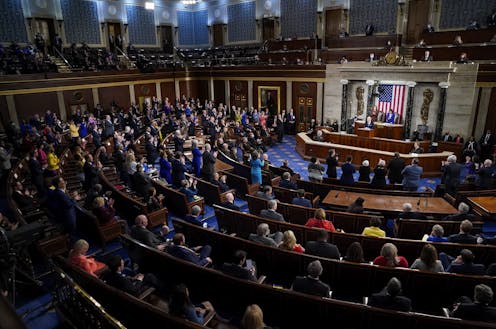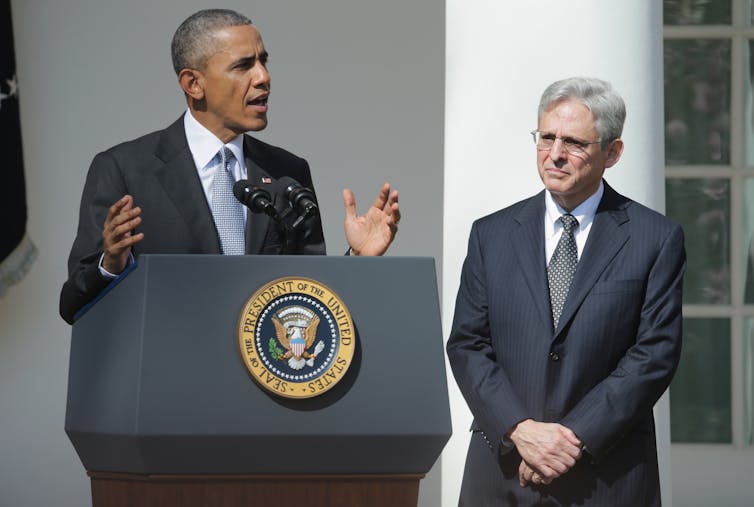
As President Joe Biden’s approval ratings continue to hover around 40% and polls consistently show that most Americans do not want him to run for reelection, Biden’s spokespeople insist that he plans to run.
It would be more surprising if he did not run.
No eligible sitting president has declined to run for reelection since 1968. Announcing that he does not plan to run would make Biden an early lame duck and make it much harder for him to accomplish his goals.
‘A lot of little things’
A lame-duck president leaves office at a known time. Second-term presidents and presidents who have just lost their reelection campaign both fall into this category, as well as presidents who choose not to seek a second term.
In nature, a lame duck is particularly vulnerable to predators because it cannot keep up with the other ducks. Before the term was applied to politics, it was used in the financial industry in 18th-century England to refer to someone in financial distress and thus vulnerable to creditors. In politics, lame ducks are defenseless against rivals because the rest of the political world has moved on and left them stumbling behind.
For the period between the election in November and inauguration in January, lame ducks are often unable to do anything legislatively. Instead, they are able to accomplish only what they can do on their own.
This is when many presidents issue a lot of pardons, particularly controversial ones. But their legislative records during their lame-duck period are dismal, since Congress has little incentive to work with someone who will soon be gone.
Post-election lame ducks have been a political problem since early in American history.
In 1801, John Adams appointed dozens of “midnight judges” to seats created by the Federalist Congress, to try to limit the powers of incoming President Thomas Jefferson and his allies in Congress.

In 1861, outgoing President James Buchanan did nothing to try to stop the secession of Southern states, seeing them as Abraham Lincoln’s problem. Benjamin Harrison took steps in 1893 to try to damage the economy just to make it harder for Grover Cleveland to govern. Herbert Hoover in 1933 would not change course on economic policy, despite the public’s electing Franklin Roosevelt and clearly wanting change.
By the early 1930s, frustration with these lame-duck periods led to the adoption of the 20th Amendment, which moved the date of presidential inaugurations back from March 4 to Jan. 20, shortening the lame-duck period by six weeks.
With less time to linger, presidents have still found ways to take a lot of little actions to try to build their legacy, protect their accomplishments or, especially for those who have lost a reelection campaign, to make life more difficult for the next president. Barack Obama used executive orders in the final two years of his presidency to achieve policy goals he had been unable to push through Congress. Donald Trump used executive orders to make last-minute changes intended to create additional headaches for Joe Biden.
‘Old news’
Some presidents are lame ducks for longer periods – the ones who cannot run again after serving two terms, or the rare few who have announced during their first term that they will not run for reelection. They face a different governing problem.
Second-term presidents are generally able to accomplish things for the first two years of their second term, perhaps three if they are popular. But once the next election cycle starts, the press and the public both shift their attention to the candidates, and the president loses a great deal of his ability to control the media narrative or reach the public.
Once candidates declare that they are running, the press treats lame-duck presidents as old news, with a dismissive attitude toward anything the outgoing president might be doing.
Congress, especially one controlled by the opposition party, will often take a similar approach. In Obama’s final year as president, for example, Republicans in Congress blocked all his efforts, including his attempt to appoint a justice to a Supreme Court vacancy.
As a scholar of the presidency who has studied elections and transitions, I believe that if Biden announces he is not running for reelection, there will be an immediate and unavoidable shift in the media, Congress and the Democratic Party leadership to a focus on the 2024 election. He will face the same kind of treatment past lame ducks have experienced, especially if the Republicans win control of the House or the Senate, or both, in the 2022 midterm elections.
Opens the field
Biden’s fate at the hands of Congress, the press and the public may be even worse, since a decision not to run again is very likely to be seen as a failure.
Only three first-term presidents have declined to run for a second term. The most similar case was Lyndon Johnson, who had served about five years, finishing the term of the assassinated President John F. Kennedy before being elected to a full term of his own in 1964.
When Johnson decided not to run for reelection in 1968, he was losing public support in the face of an unpopular war in Vietnam and major opposition from within his own party.
It is not clear exactly when he decided not to run again, but his announcement that he was not running was not made until after the New Hampshire primary in early 1968. By that point, his ability to effectively govern had already been badly damaged by fallout from the Vietnam War, and media attention quickly shifted away from him to focus on the candidates who might replace him.
If Biden announces he is not running, that will open up the field for potential Democratic candidates who are not willing to run against a sitting president of their own party. These candidates will want to know as soon as possible so they can launch their campaigns early.
But Biden will want to delay the announcement to keep the media focus on his administration and the policy goals he hopes to achieve, especially those that require action by Congress. After all, his term of office continues until Jan. 20, 2025, whether he runs again or not. To accomplish anything in those last two years he will need to keep the media and Congress focused on his administration.
This will cause a strain between the would-be presidents and the man who currently holds the office. But Biden, like any president, is more concerned with his own agenda than with the campaigns of others. His agenda stands a better chance if he runs than if he does not.
Still, the combination of old age and unpopularity makes it plausible that Biden would decide to forgo a second term. If he makes that decision, he will likely hold off as long as possible before announcing it. From the moment he becomes a lame duck, the most productive days of his presidency are sure to be behind him.
Michael J. Faber does not work for, consult, own shares in or receive funding from any company or organisation that would benefit from this article, and has disclosed no relevant affiliations beyond their academic appointment.
This article was originally published on The Conversation. Read the original article.







